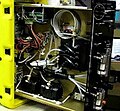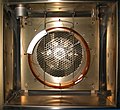Gas chromatography: Difference between revisions
CSV import |
CSV import |
||
| Line 35: | Line 35: | ||
{{stub}} | {{stub}} | ||
<gallery> | |||
File:Gas_chromatograph-vector.svg|Gas chromatograph vector diagram | |||
File:(Gas_chromatograph.)_-_DPLA_-_6f678040232669661dcfb95308013cc0.jpg|Historical gas chromatograph | |||
File:Microsyringe_based_autosampler.gif|Microsyringe based autosampler | |||
File:Split_splitless.png|Split/splitless injector diagram | |||
File:GeoStrataEclipse.jpg|Gas chromatography equipment setup | |||
File:GCruleof10.jpg|GC rule of 10 | |||
File:GC_Oven_inside.jpg|Inside of a GC oven | |||
</gallery> | |||
Latest revision as of 11:20, 18 February 2025
Gas chromatography (GC) is a common type of chromatography used in analytical chemistry for separating and analyzing compounds that can be vaporized without decomposition. This technique is typically used for testing the purity of a particular substance, or separating the different components of a mixture. In some situations, GC may help in identifying a compound.
Principle[edit]
Gas chromatography is in principle similar to column chromatography, but has several notable differences. The sample solution injected into the instrument enters a gas stream which transports the sample into a separation tube known as the "column." Helium or nitrogen is used as the carrier gas to transport the molecules through the column.
Components[edit]
A gas chromatograph is a chemical analysis instrument for separating chemicals in a complex sample. A gas chromatograph uses a flow-through narrow tube known as the column, through which different chemical constituents of a sample pass in a gas stream (carrier gas) at different rates depending on their various chemical and physical properties and their interaction with a specific column filling, called the stationary phase.
Injector[edit]
The injector serves to introduce the sample into the continuous flow of carrier gas. The injector should introduce the sample in a reproducible manner and without causing sample decomposition.
Column[edit]
The column is where the components are separated; it is the heart of the system. The column can be packed or capillary. Packed columns are the routine and economical option, and are still widely used for routine analyses.
Detector[edit]
The detector is the device that sees the separated components; it provides a signal proportional to the amount of sample component emerging from the column. Hence, the detector is the sensing portion of the system.
Applications[edit]
Gas chromatography is widely used in applications involving pharmaceuticals, food chemistry, fire investigation, environmental analysis, and explosives investigation. It is also used in the advancement of medicine, science, and technology.









